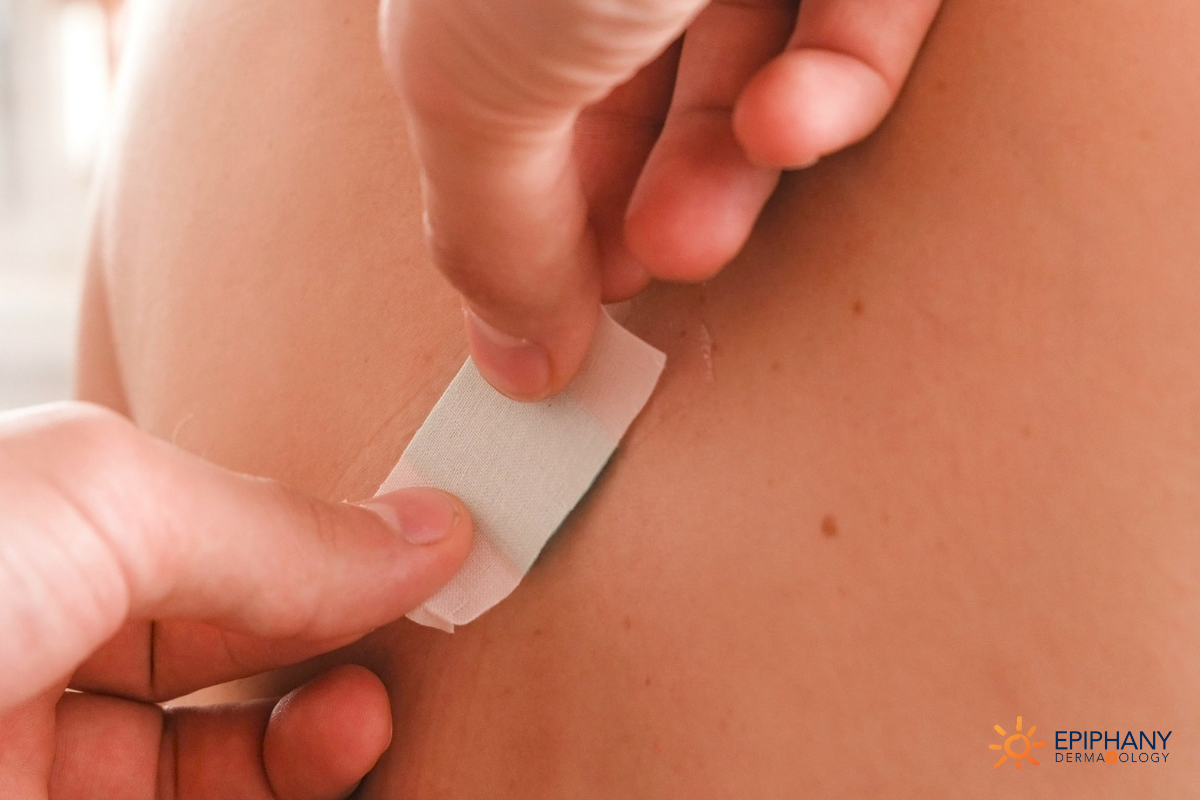A skin excision is a surgery where we cut out damaged skin tissue. It is a full thickness removal — meaning we remove all layers of the tissue (epidermis, dermis, and into the subcutaneous fat layer). We then suture it back together with stitches for optimal healing.
What Types of Skin Problems Require an Excision?
Excisions can be done on malignant tumors or benign lesions.
For example, we can excise a benign sebaceous cyst that may be painful, enlarged, or inflamed. We will remove the cyst with a narrow margin around it. Yes, it’s benign, but it’s painful, inflamed, or otherwise unwanted, so we get rid of it.
We take a similar approach with skin cancers. We remove a wider margin with skin cancers (taking away more tissue surrounding the tumor) to ensure all of the cancer is fully removed. After malignant skin cancer tumors are removed, we examine the margins to make sure no cancer remains in the skin.
Are There Different Types of Skin Excisions?
Yes, there are two different types of skin excisions.
The most common type we use is called an elliptical excision. In this type of excision, we remove a football or canoe shaped area of skin. By removing lesions in this shape, we can more easily suture the skin back together and achieve better cosmetic results.
The second type of skin excision is a deep saucerization. This technique removes a deeper scoop of tissue that leaves a circular defect or wound. With this procedure, there’s often no intention of suturing or sewing the skin back together— it’s left to heal naturally.
Often people ask if punch excisions are a necessary treatment. Punch excisions are not a true excision. They are actually a type of biopsy. If we suspect a lesion of cancer or if we need more information to correctly diagnose a suspicious rash, we may choose to take a punch biopsy to send to a pathologist for further evaluation.
What Should You Expect During an Excision?
An excision is an in-office procedure that only requires local anesthesia. We inject the anesthesia directly into the affected area so that patients experience little, if any, pain. The procedure takes 15-30 minutes depending on the size and depth of the skin excision. Patients remain awake and fully informed during their excision.
Once the excision is performed, the lesion is placed in a specimen container and sent to the pathologist for evaluation. The dermatopathologist checks the margins or gives us a diagnosis if necessary.
Sutures are placed and the wound is bandaged. We’ll give you instructions on how to care for the wound until sutures are removed and the wound heals.
Expect to have sutures for 7-14 days. Pain is usually quite minimal and lasts no more than 24-48 hours. Some patients experience slightly more pain than expected with excisions performed on the wrist, ankle, or nose. In other places, pain is minimal. Most pain or discomfort can be easily managed by taking over-the-counter Tylenol or Ibuprofen.
Skin Excision FAQs
What’s the infection risk?
Rates of infection on excisions are less than 1%. Because the infection risk is so low, patients do not need antibiotics unless they have a specific condition that requires additional precautions. For patients with recent joint replacements, a mechanical cardiac valve, or a history of rheumatic fever, we usually opt to place them on an antibiotic as a preventative measure.
What will my scar look like after the excision?
It depends. People heal at different rates in different ways. We can’t guarantee the way your scar will heal, but ideally, your scar will be barely noticeable.
It usually takes the shape of a pencil-thin line. We do our best to orient the scar in normal human lines, wrinkles, and folds so that it’s hidden in plain sight.
Our objective is to make the scar as minimal as possible — so unnoticeable that at conversational distance, no one would see the scar.
Does an excision hurt?
You can expect minimal pain for 24-48 hours, easily controlled with Ibuprofen and Tylenol. If necessary, you can also use cold compresses to alleviate any swelling or tenderness.
Should I inform my doctor of past health conditions?
Yes, if you have a joint replacement, pacemaker, defibrillator, or have recently had immunosuppression treatment, let your doctor know. We usually ask about these issues in a consultation, but sometimes patients don’t tell us about these health conditions. We need to know so we can operate accordingly and keep your rate of infection to a minimum.
What are my limitations after a surgical excision?
It’s important to know the physical limitations following your excision. Do not engage in strenuous physical activity or submerge in pools or lakes after your surgery. In other words, don’t schedule a round of golf or time on the lake for the afternoon after your procedure.
Depending on the anatomical site, some physical activity is allowed — it just depends on the exact location of the excision. Ask your doctor specifically what you can and can’t to (including travel plans) and they will explain the physical limitations necessary for your healing.
Can I keep my specimen?
No. In most cases, we need to send it to the pathologist for screening. They’ll make sure there’s nothing atypical or cancerous about the lesion. If it is cancerous, the pathologist will make sure the margins are clear and the cancer is fully removed.
Additional Resources
Click here to find an Epiphany provider near you.

